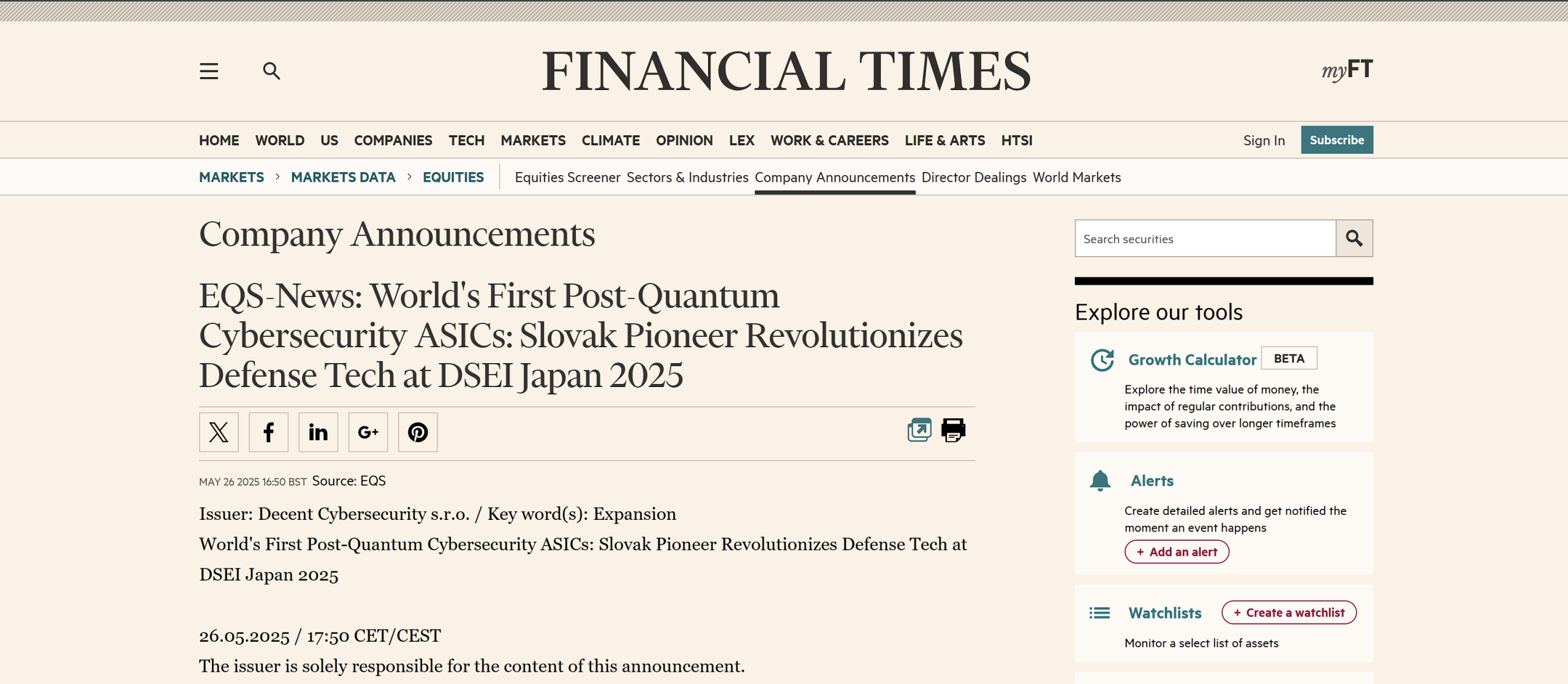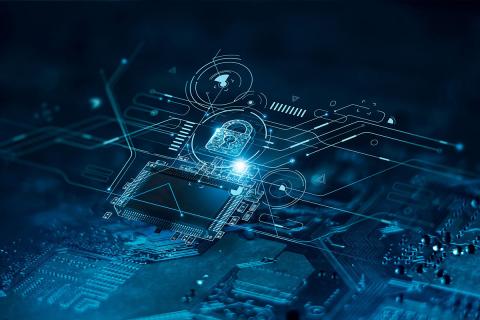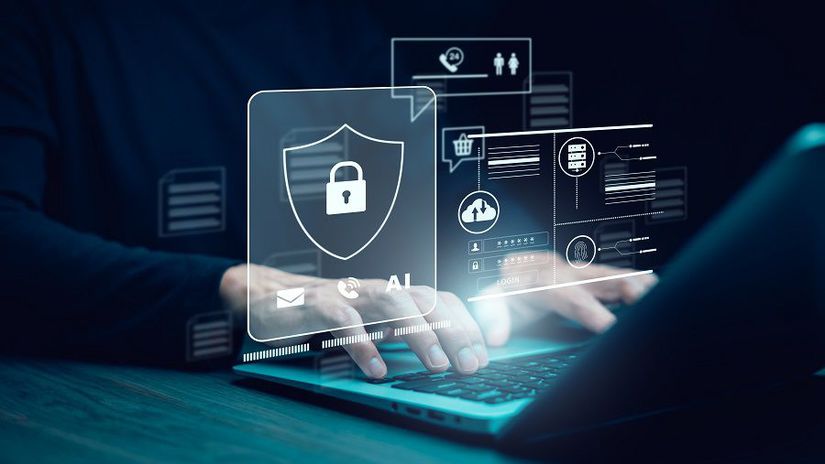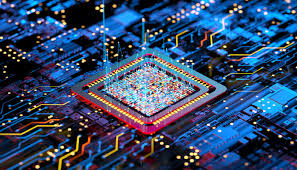Overview of Sectors and Challenges
INTRODUCTION
Quantum computing technologies (quantum computers and related systems) have the potential to transform entire industries, shift human society and help solve hitherto unsolvable problems. Unlike classical computers using bits (0/1), quantum computers use qubits, which, thanks to the principles of superposition and entanglement, enable parallel calculations and solutions to certain tasks exponentially faster. Since 2000, there have been significant advances in quantum computing – the first prototypes were developed, and in 2019, Google researchers demonstrated the so-called quantum computing. quantum supremacy, when their 53-qubit processor Sycamore solved a specific task in ~200 seconds, while a classical supercomputer would take thousands of years. Although full-fledged quantum computers are still in development, governments and companies are investing billions in so-called quantum computing. quantum programmes and strategies. This overview summarizes the expected impacts of commonly available quantum computers (i.e. quantum computers deployed outside laboratories, available to industry and other entities) on various areas: industry and economy, information security, labour market, society (social and demographic aspects), ethics, as well as selected futuristic predictions further development. We take into account studies and analyses published after 2000 and cite sources from reputable databases and institutions (IEEE, Springer, Nature, ScienceDirect, arXiv, World Economic Forum, MIT Technology Review and others).
1. INDUSTRY AND ECONOMY
Quantum computers promise to make fundamental changes in several industries thanks to their ability to solve hitherto insurmountable computational tasks. Optimization problems and simulations of complex systems are two key examples. Quantum algorithms can more efficiently search for optimal solutions in huge combinatorial tasks, which has applications in logistics (optimization of routes and supply chains), in the financial sector (e.g. advanced risk analysis and optimization of investment portfolios) or in industrial production (production schedules, efficient use of resources). Quantum simulations, in turn, will make it possible to model complex molecular and physical processes, which will accelerate the development of new drugs and materials – breakthroughs are expected in pharmacology (e.g. design of life-saving drugs) and material sciences (e.g. new battery chemicals, more efficient catalysts). These innovations could bring significant increases in efficiency and productivity across industries – reducing waste, accelerating product development, increasing profitability, etc. From a global perspective, quantum computing is considered a factor that can exponentially accelerate the onset of the fourth industrial revolution, along with AI, robotics or IoT.
1.1 Benefits for industry in various sectors
Chemical and pharmaceutical industry: Quantum simulations of molecules will help discover new drugs and materials faster than before. For example, modelling drug-protein interactions or designing efficient solar cells can be done by a quantum computer in a reasonable amount of time, which today takes years for a supercomputer.
Finance: Fast quantum optimization algorithms can improve investment decision-making, portfolio management, and financial risk modelling. They will also allow for more comprehensive encryption of transactions (see Security below).
Transport and logistics: More efficient algorithms for the so-called “Transport Strategy”. NP-complete problems (as a business traveller) will increase traffic flow, reduce fuel costs, and speed up supply chains.
Energy: Quantum modelling will help design better batteries, optimise power grids and manage real-time energy distribution according to demand.
According to several analyses, the economic benefits of quantum computing will be very high. For example, a report by the Boston Consulting Group estimates that the market for quantum hardware and software will reach USD 5-10 billion per year by the end of the 2020s, with the advent of powerful quantum computers in the 1930s. Other projections speak of up to $1 trillion in value added for the world economy in 2025-2035. Such growth will be exploited mainly in multi-trillion industries, such as finance, defence, life sciences, telecommunications and manufacturing. The greatest benefits are expected in finance (annual contribution of ~USD 20 billion by 2030) and defence industry (~USD 10 billion per year). However, it is important to note that these economic benefits will not be distributed evenly. The main beneficiaries are likely to come from countries and regions that are investing massively in quantum research and infrastructure today. The analyses highlight those countries such as the US, China, EU countries (Germany, France, UK) and Japan are at the forefront and can grab a substantial part of the value created by quantum computing by 2035. Conversely, countries without strategic investments may be lagging behind (see the Society section below). For leading countries and companies, quantum technology will mean strengthening the industrial base, the emergence of new industries and products, and last but not least, benefits for national security (for example, the development of quantum-resistant ciphers or quantum sensors for the military).
2. LABOUR MARKET
The wide availability of quantum computers will also bring significant changes to the labour market and in the requirements for workers’ qualifications. The emergence of completely new specialized positions and fields is expected, but also the need for retraining in many existing professions. There is already an increased demand for quantum informatics experts, quantum engineers (developers of quantum hardware and software) or researchers in the field of quantum algorithms. McKinsey’s analysis states that there is currently only 1 qualified candidate for every 3 jobs in quantum technology, indicating a significant talent gap. By 2025, up to half of quantum positions could even remain unfilled, unless there is intensive training and recruitment of new experts. In response, there are initiatives at the level of governments and companies aimed at building a quantum-literate workforce – new university programs focused on quantum technologies are being created and experts from related fields (computer science, physics, mathematics) are being trained to master the principles of quantum computing.
2.1 Creating new jobs
Unlike some other technologies (e.g. AI), quantum computing does not envisage mass automation of human labour, but rather the emergence of complementary industries and job opportunities. Estimates speak of tens to hundreds of thousands of new jobs on a global scale. According to a report by Quantum Insider, the quantum economy can create around 250,000 new jobs by 2030 and up to 840,000 jobs across different sectors by 2035 . These positions will include not only quantum scientists and engineers, but also positions in applied research (e.g. chemists using quantum simulations), IT security (specialists in post-quantum ciphers), consultants for quantum technologies in industry, product managers for quantum services, educators and trainers, etc. As quantum computers permeate various industries, knowledge of quantum principles is expected to become a valued skill even among professionals who do not directly develop quantum hardware – similar to how many IT workers today are expected to have at least a basic knowledge of machine learning or data analytics.
2.2 Threats to jobs and the need to adapt
Although quantum computing as such rather complements existing computing tools, its deployment may indirectly lead to the disappearance of some tasks or professions. For example, if quantum algorithms can significantly streamline optimization processes, this can reduce the need for manual labour in transportation planning or scheduling – these activities will be taken over by quantum-enhanced software tools. Similarly, in the field of cybersecurity, automated quantum data analysis can detect anomalies and threats faster than human analysts, so some of the routine analytical work disappears. On the other hand, however, new positions will arise for the supervision of these quantum systems and for the interpretation of their outputs. Most experts agree that quantum computing will not cause sudden large-scale unemployment, but will require an adaptation of the workforce – continuous education, retraining at-risk workers for new roles, and integrating quantum tools to increase people’s productivity instead of replacing them entirely. Governments and companies will likely need to invest in reskilling programs similar to other breakthrough technologies (AI, automation) to make the transition to the quantum era smooth and inclusive.
3. SOCIETY AND DEMOGRAPHIC IMPACTS
The rise of quantum computing raises broader societal changes and questions, especially regarding equity of access to this breakthrough technology and its geopolitical implications. Already today, we can see the contours of a potential “quantum divide” – similar to the digital divide – between those who have quantum capacities available and those who do not. As of January 2021, only 17 countries in the world had developed a national quantum strategy or significant investments in quantum research, while more than 150 countries have no strategy. This imbalance raises concerns that states without access to quantum technologies will lag behind in both economic and technological development in the coming decades. The World Economic Forum warns that unequal access to quantum innovation would have negative geopolitical impacts, with countries with less developed programs risking falling even further behind and increasing their dependence on tech powers. The same is true within countries: if just a few large corporations gain access to quantum computers, they can dominate entire industries and crowd out competitors, which will deepen economic inequality in society. Ronald de Wolf (2017) warns that if quantum computing initially remains available only to a narrow group (such as governments, tech giants, or wealthy firms), there is a risk of a concentration of power between the US and the rest of the world, as well as between a few corporations and the rest of society. For example, if only one pharmaceutical company had a quantum computer and used it to develop drugs, it could overtake all competitors and gain a monopoly in the drug market. Such a development would weaken the competitive environment, concentrate profit and influence in the hands of individuals, and increase inequality.
But from the perspective of society as a whole, quantum technologies also hold great promise: for example, they can help solve humanity’s global problems – from climate models, to the development of new energy sources, to improving healthcare. Quantum computers could contribute to more efficient design of disease treatments (e.g. personalized medical simulations), optimize urban systems (transport, smart grids) or even improve the modelling of economic and demographic trends for better policy decision-making. However, so that these benefits are not limited to developed countries and elites, experts emphasize the need for inclusive and responsible development. In its “Quantum Economy Blueprint” (2023), the WEF calls for making quantum technologies accessible to all nations and societies and for building a quantum-literate population to avoid new gaps. In particular, it is recommended to invest in education (from primary schools to universities) in quantum science, promote open science and international cooperation, so that smaller countries also have a chance to participate in the quantum era.
Historically, there is a precedent that initially exclusive technologies are democratized over time. De Wolf points to an analogy with mainframe computers in the 1950s – only a few companies could afford them then, but the advent of PCs and later smartphones made computing power available to the masses thanks to the exponential improvement in technology (Moore’s Law). Similarly, in quantum computing, it is hoped that the initial phase of expensive prototypes will be followed by a phase of widespread availability through cloud services: ordinary users and small businesses will not need to own a quantum computer, but will be able to rent time on powerful quantum machines remotely. Such a model (Quantum Computing as a Service) could mitigate the risk of monopolization of access, similar to how cloud computing democratizes access to supercomputers today. An example is the IBM Quantum Experience initiative, which has allowed the public to freely experiment on a small 5-qubit quantum processor over the Internet since 2016. In the future, commercial quantum clouds with much higher performance are expected to flourish, and the task of regulators and governments will be to ensure that there is fair access to them and that the dominant position of their operators is not abused.
Demographically, the quantum revolution can be expected to have similar characteristics to previous technological revolutions – younger generations tend to pick up new technologies more quickly (so-called “new technologies”). Digital natives will also be quantum natives), while older generations will adapt to them more slowly. This place demands on education systems to continuously incorporate the basics of quantum informatics into curricula (which is already happening at the level of universities and gradually also at the level of secondary schools in some countries). The aim is for the future workforce to be ready and to shrink the knowledge gap between researchers and the public in this difficult field. If quantum technologies are perceived as “mysterious” and only for the initiated, it may reduce public support and increase concern. On the contrary, if quantum technologies can be popularized and explained in an understandable way, the wider society will be able to participate in the discussion about their direction and use.
4. ETHICAL CONSIDERATIONS
The advent of quantum computers also raises several ethical and philosophical questions. Many of them are related to the already mentioned themes of inequality and privacy, but new dilemmas are also emerging, specific to the quantum era.
4.1 Privacy and surveillance
Quantum computers capable of breaking conventional encryption (see the Security section) can significantly weaken the concept of digital privacy. Information that is securely encrypted today (banking and health records, emails, sensitive communications) could be decrypted and exposed in the future. “A lot of information that is kept secret today for a good reason could end up on the street. Privacy would be greatly weakened,” writes de Wolf. This poses complex ethical questions before society: If states or corporations are given the ability to easily decrypt almost any communication, where will the line be between legitimate surveillance for security reasons and the preservation of individual privacy? There is already a sensitive debate about the balance between national security and the right to privacy – quantum technologies can tip this balance even further. Moreover, not all actors may have access to quantum decryption at once; There is a risk of abuse by those who get it first (e.g. governments for mass surveillance of citizens, authoritarian regimes to suppress the opposition, or criminal groups to steal data). All of this requires strong ethical principles and possibly new laws: international agreements not to use quantum computing for illegitimate espionage, obligations by governments to transparency if they had such capability, and so on.
4.2 Security and military use
As with any breakthrough technology, a dilemma arises around the potential militarization of quantum technologies. Quantum computers can help good things (e.g., looking for a cure for cancer), but in the wrong hands they can also help bad things – for example, designing new weapons or cyberattack tools. Already today, the great powers are competing to gain a quantum lead, also for defensive purposes. The ethical challenge is to prevent a quantum arms race and to ensure that quantum discoveries serve primarily peaceful goals. Some philosophers warn of the risk that quantum computing power could also facilitate terrorism or mass surveillance if not regulated. Therefore, efforts towards international quantum governance are appropriate – just as there are agreements on the non-proliferation of nuclear weapons, cooperation on the responsible use of quantum technologies should be formed. The World Economic Forum (2022) initiated debates on quantum ethics and governance, emphasizing the need for global standards and oversight for the quantum revolution to take place safely and inclusively.
4.3 Equality and justice
Already in the section Society, we have outlined the ethical problem of the potential deepening of inequalities. From an ethical point of view, it is crucial to ask who will benefit from quantum conveniences. If the benefits (e.g. new medicines, better batteries) should remain only in rich countries or in the hands of a monopoly, it may be perceived as unfair socially. Therefore, the ethics of technology dictates that we look for ways to maximize the benefit of society as a whole and minimize the negatives. De Wolf notes that these questions are not entirely new – similar ethical dilemmas have accompanied the advent of classical computers or artificial intelligence – but in the case of quantum computers, they can be exacerbated by the extreme difference in possibilities between those who have quantum computing and those who do not. Responsible Research and Innovation (RRI) is an approach recommended by social scientists and ethicists: it involves involving all stakeholders (researchers, industry, governments, but also the public) in an early discussion about the development of technologies so that the resulting innovations reflect societal values and goals. For quantum technologies, this means already opening a public debate on what applications we want to support, how to address risks (e.g. overseeing the use of quantum computers in accordance with human rights), and so on. The scientific community should maintain open access to knowledge – i.e. publishing research results instead of keeping them secret within companies – so that know-how is not closed and can be used by a wider range of people. Intellectual property issues also arise: patenting quantum algorithms or techniques could slow progress or favour a few players; some experts therefore propose models for sharing these discoveries (e.g., open-source quantum software libraries) for the benefit of society as a whole.
4.4 Philosophical implications
An interesting – albeit more abstract – aspect is how quantum computers will affect our understanding of the concepts of knowledge, reality, and information. Quantum mechanics is known for its counterintuitive phenomena (superposition, uncertainty, distance linking), and the very existence of quantum computers that use these phenomena raises debates in metaphysics and epistemology. For example, physicist David Deutsch argues that that a functioning quantum computer would be proof of the Many-Worlds interpretation of quantum theory (which says that parallel branches of reality are physically real). Others talk about “quantum informatics” as a new paradigm – we could expand our definition of information and computation, since we do not understand quantum bits in exactly the same way as classical bits. From an ethical point of view, this does not yet have direct implications, but it is a reminder that the quantum revolution will affect not only the practical world, but also our philosophical vision of the world.
In summary, the ethical challenge of quantum technologies is to maximize the positive benefits to humanity while minimizing risks. This will require international cooperation, wise regulatory interventions and a constant reflection of the values we put into this new technology.
5. INFORMATION SECURITY
One of the first areas where quantum computers have raised serious concerns and increased activity is information and cybersecurity. The reason for this is the well-known fact that the powerful universal quantum computer can efficiently factorize large numbers using the Shor’s algorithm, thus breaking the basic cryptographic systems used on the Internet (RSA, Diffie-Hellman, elliptic curves). Modern public-key encryption is based on mathematical tasks that classical computers cannot do in a reasonable time (e.g., it would take classical supercomputers longer than the age of the universe to decompose a 2048-bit number into prime numbers) – but quantum computers undermine this assumption. The expert consensus is that quantum computers capable of running the cryptographically relevant Shor algorithm (the so-called CRQC – Cryptographically Relevant Quantum Computer) could be created during the 2030s. The US Department of Homeland Security estimates that a rugged quantum computer could break today’s public ciphers as early as around 2030. Although some more conservative estimates (e.g. the MITRE report) push this horizon as far as 2055–2060, it is more of a difference in the degree of caution – almost all experts agree that in the second half of the 21st century, today’s asymmetric cryptography will be ineffective. In addition, the threat is already relevant today in the form of “Harvest Now, Decrypt Later” attacks – attackers can already intercept encrypted communications (e.g. sensitive government data) and store them to decrypt them later when they have a quantum machine at their disposal. The NSA warns that if malicious actors manage to secretly develop a quantum decryption tool before moving to new standards, the impact could be devastating for national security – an attacker would gain access to vast amounts of sensitive information. From personal data to financial data to military secrets.
5.1 Post-Quantum Cryptography
The security community’s response to this threat is the intensive development and deployment of quantum-resistant cryptographic algorithms, often referred to as post-quantum cryptography (PQC). These encryption methods are based on problems (e.g., lattice problems, coding, multivariate polynomials) that neither quantum nor classical computers can solve efficiently. In 2016, NIST (US National Institute of Standards and Technology) announced an international competition for such algorithms, and in 2022 it selected the first PQC standards – for example, the CRYSTALS-Kyber (encryption) and CRYSTALS-Dilithium (digital signatures) algorithms. Many governments have already issued guidelines for the transition to quantum-resistant ciphers. In the US, President Biden signed National Security Memorandum No. 10 in May 2022, which imposes a plan on federal agencies to migrate their systems to post-quantum encryption and sets a goal to mitigate quantum risk by 2035. The European Union and other countries are proceeding in a similar way. The challenge is that updating a cryptographic infrastructure is a lengthy and complex process – requiring modification of countless software applications, protocols, and devices, which can take over a decade. Therefore, experts are appealing for immediate action: organizations should start taking stock of their cryptographic uses now and implement the so-called “Crypto Protection”. Crypto Agility (the flexibility to quickly switch to new algorithms as they become available).
5.2 Quantum cryptography
In addition to post-quantum “classical” cryptography, there is also an approach that uses quantum principles themselves to increase security – the so-called “classical” cryptography. quantum communication and quantum key distributions (QKD). These are techniques where security is based not only on mathematical difficulty, but on the laws of physics: information is encoded into quantum states (e.g. photon polarization) and, according to the principle of uncertainty, any attempt to eavesdrop on this information changes or destroys this information, so that it reveals the presence of an attacker. Pilot quantum networks already exist, such as China’s Beijing-Shanghai quantum line or experimental satellite QKD links. Quantum communication networks promise an almost absolutely secure connection – the so-called “Quantum Network”. Unhackable nets. Their disadvantage so far is their range (they need direct optical connections or satellites) and the fact that they only deal with key distribution, not bulk data encryption. However, in combination with post-quantum algorithms, they can form the basis of a new era of security. Many governments (China, EU, US) are investing in building a quantum internet that integrates quantum communication nodes for critical applications (government communications, banking, health data transmission, etc.).
5.3 Other Security Applications
Quantum computers are not only a threat, but also a tool for defenders. They can help improve the security of systems, for example, by quickly analysing complex encryption schemes and looking for weaknesses in them (thus helping to design more resilient algorithms). They can also improve authentication mechanisms (e.g. generate complex one-time passwords or patterns that cannot be cracked by a classic computer). Quantum random generators (which use quantum uncertainty) can provide truly random numbers, which will strengthen cryptography (most security protocols need high-quality chance). In the field of cyber defence, quantum computers could help detect anomalies in the network – thanks to their ability to search multidimensional data spaces faster, they can detect unusual patterns of behaviour in network traffic or malicious code hidden in huge amounts of data.
Summary: In information security, quantum computers are a double-edged sword. On the one hand, they undermine the current encryption foundations and force the world to urgently innovate in cryptography. On the other hand, they offer new ways to increase security even further (quantum cryptography). The timing will be key – whether the protective measures (post-quantum ciphers, QKD networks) will be able to expand before the moment comes when attackers actually gain a quantum computing advantage.
6. FUTURISTIC PREDICTIONS AND OUTLOOK
The outlook for the future of quantum computers is a combination of high expectations and uncertainties. The following decades will bring a gradual transition from current experimental and NISQ (Noisy Intermediate-Scale Quantum) devices to fully scalable, resilient quantum computers with error correction. Experts agree that in the 2030s, we will already see quantum computers routinely solving some specific tasks better than classical computers – a point called quantum advantage. It is even expected that the first demonstrations of practical quantum advantage will occur within 5 years (around 2030) in areas such as machine learning or optimization. A KPMG survey of companies showed that 78% of US and 60% of Canadian companies believe that quantum computers will be commonly deployed by 2030. This optimism is shared especially by technology leaders who are They are investing in quantum development – for example, IBM, Google, Microsoft are announcing steady progress in increasing the number of qubits and the quality (quantum volume) of their devices every year.
On the other hand, the exact timing of major breakthroughs (such as a fully fault-tolerant quantum computer with thousands of logical qubits) remains unclear. As mentioned in the security section, estimates of a breakthrough in decryption vary by decades. A RAND report (2023) states that there is a general consensus that commercial uses of quantum computers will come before their use to decrypt classified information. In other words, we are likely to see practical applications in the industry rather than a full-blown threat to cryptography. For example, an analysis by Parker et al. (2023) estimated that simulating a certain chemical catalyst for direct CO₂ capture would require only ~20% of the number of qubits required to break RSA-2048. This implies that useful quantum computing (e.g. for climate technologies) may be available with smaller machines than would be necessary to compromise the global security of ciphers.
6.1 Short-term outlook (until ~2030)
In the next 5-7 years, quantum computers are expected to be primarily a cloud service offered by big players (IBM Quantum, Amazon Braket, Google Quantum AI, etc.). The number of physical qubits in devices will grow into the thousands, but most of them will still be error qubits without complete correction (i.e. NISQ machines). These machines will be used to experiment and develop quantum algorithms in real-world conditions. The first breakthrough applications could occur during this period: for example, quantum computers can help discover new high-temperature superconductors, design optimized AI models (quantum machine learning), or improve the accuracy of weather and climate forecasts. Quantum sensors will also begin to connect with AI – a combination of highly sensitive measurements and machine learning will open the door to, for example, breakthrough medical diagnostics using imaging methods, more accurate exploration of natural resources, or navigation without GPS using inertial quantum sensors. By the end of the decade, quantum computers could achieve quantum advantage in narrowly specialized tasks (e.g., simulating a specific molecule or solving a specific optimization problem faster than the best classical algorithm).
6.2 Medium-term outlook (2030-2040)
During this period, we will probably see the first quantum computers with error correction. This means that they will be able to perform long-lasting computations without the influence of decoherence and noise, thanks to the implementation of quantum correction codes (which require enormous numbers of physical qubits per logical qubit). If technological challenges can be overcome, quantum machines could exist around the middle of the century with millions of physical qubits, which would be equivalent to hundreds or thousands of logical qubits. With such a capacity, quantum computers would clearly surpass classical ones in many areas. It would be possible to run complex quantum algorithms such as Shor’s algorithm for very large numbers – which would definitively collapse classical cryptographic schemes (which is why it is necessary to migrate to PQC by then, see above). Quantum computers would also be able to simulate entire biological systems at the molecular level, which would revolutionize biotechnology and medicine (for example, accurate simulations of human cells will make it possible to design treatments “on the computer” without lengthy clinical trials). In chemistry and materials science, new compounds with desired properties (e.g. ultra-strong and lightweight materials, extremely efficient batteries, eco-friendly plastics) designed by quantum computing could emerge. In finance and economics, quantum algorithms could optimize global investment strategies or drive economic models with a huge number of variables in real time. Quantum artificial intelligence can be created – AI models using quantum circuits that will potentially surpass the capabilities of today’s ones (e.g. in training speed or in the possibilities of working with huge data). Some futurologists are even considering a synergy between quantum computing and artificial general intelligence (AGI), which could significantly accelerate the arrival of AGI – although it is a speculative field and at the same time potentially risky (the so-called „AGI”). ultimate black box problem – quantum AI could be even less explainable than today’s neural networks).
6.3 Long-term outlook (2040 and beyond)
If trends continue, quantum computers could be as common by the end of the century as classic supercomputers or cloud servers are today. While they won’t be on every table (they’re likely to remain large and infrastructure-intensive), their services will indirectly connect almost every aspect of life. Imagine the quantum cloud infrastructure that powers smart cities: a quantum optimizer controls transportation, a quantum network manager distributes energy, hospitals use quantum AI diagnostic assistants, and pharmaceutical companies regularly discover drugs with the help of quantum simulations. Quantum computing in combination with classical (hybrid systems) is likely to be the standard – where quantum machines excel, they will be deployed, elsewhere the classical computer will take over. We can also expect new paradigms such as the quantum internet connecting quantum computers to each other (allowing even distributed quantum computing) and quantum sensors forming the Internet of Quantum Things.
Of course, these futuristic visions assume that all current scientific and engineering obstacles (decoherence, qubit scaling, cooling, reliable quantum operations) will be overcome. It is possible that we will also encounter limits – for example, technological (the complexity of building a million-qubit system), economic (the cost of running quantum data centres) or even physical (some sceptics ask whether we will discover fundamental barriers to large-scale quantum computing). So far, however, no theoretical reason has been found why quantum computers should not work on a large scale – it is more of an engineering challenge.
From the perspective of society as a whole, it is important that the preparation for the quantum future must start now. This includes: rolling out post-quantum encryption before it’s too late; invest in the education and training of quantum experts so that demand does not exceed supply; create regulatory frameworks and ethical guidelines so that quantum technology develops responsibly; promote international dialogue and cooperation in order to minimise the risk of conflict or monopolisation. The history of technology development teaches us that those who adapt in time gain an advantage – this is doubly true for quantum computers, since the consequences of their late adoption may mean not only economic lag, but also security risks. At the same time, however, futurologists emphasize that we should not perceive quantum computers as magic devices for everything – although they will bring revolutionary changes, they will be one link in a complex technological ecosystem along with artificial intelligence, biotechnology, robotics and other inventions. Therefore, we must evaluate their impacts on society in a broader context and with a cool head, without unnecessary hype but also without underestimation.
CONCLUSION
Finally, a summary by de Wolf (2017) can be cited, which aptly describes the key impacts of quantum computers: “Quantum computers have the potential to break much of current cryptography, thereby threatening our digital economy (but also providing alternative quantum cryptography solutions). They can also optimize all kinds of processes better than before, which will lead to efficiency gains. And finally, they will enable much faster simulation of quantum systems, with the potential to better design drugs, materials, etc. … From an ethical point of view, they reduce privacy and make it difficult to hide information (for better or for worse). If access to quantum computers is limited to a few governments, it can upset the balance of power between states; And if it is limited to a few large firms, it can lead to monopoly and increase inequality in society.” These words describe that the impacts of commonly available quantum computers will be multifaceted – from technical gains to societal challenges. Human society is on the cusp of the next major era of transformation, and preparedness, awareness, and responsibility will be key for the quantum revolution to bring more benefits than problems.
References
[1.] de Wolf, R. (2017). The potential impact of quantum computers on society. Ethics and Information Technology, 19(4), 271–276. DOI: 10.1007/s10676-017-9429-1
[2.] Parker, E. (2023). When a Quantum Computer Is Able to Break Our Encryption, It Won’t Be a Secret. RAND Corporation Commentary (originally published on Lawfare). Available online
[3.] Masterson, V. (2024). Can we build a safe and inclusive ‘quantum economy’?. World Economic Forum – Centre for the Fourth Industrial Revolution. Available online
[4.] Hidary, J. & Sarkar, A. (2023). The world is heading for a ‘quantum divide’: here’s why it matters. World Economic Forum – Annual Meeting 2023. Available online
[5.] The Quantum Insider (2024). The Quantum Insider Projects $1 Trillion in Economic Impact from Quantum Computing by 2035. TQI Market Report Summary, 13 Sep 2024
[6.] Mohr, N., Peltz, K., Zemmel, R., Zesko, M. (2022). Five lessons from AI on closing quantum’s talent gap — before it’s too late. McKinsey Digital (Dec 1, 2022). Available online
[7.] Černiauskas, J. (2025). Cloud quantum computing: A trillion-dollar opportunity with dangerous hidden risks. VentureBeat (June 21, 2025). Available online [8.] Vermaas, P. E. (2017). The societal impact of the emerging quantum technologies: a renewed urgency to make quantum theory understandable. Ethics and Information Technology, 19(4), 241–246





